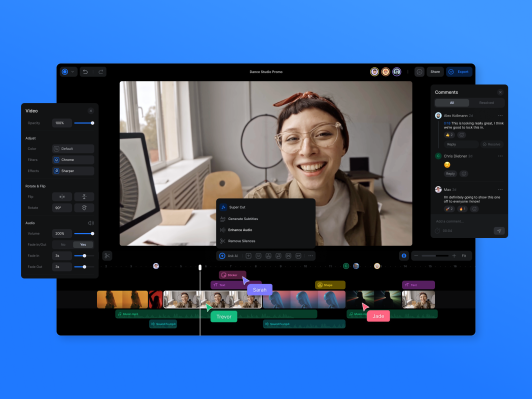Ozone, the maker of an AI-powered collaborative video editor in the cloud, has raised $7.1 million in seed funding and is launching in open beta. The Y Combinator alum aims to provide content creators with AI assistance that lets them complete repetitive editing tasks in seconds, rather than in hours. Ozone doesn’t want to replace human creativity with AI, it instead wants to give content creators tools to create engaging videos faster and more efficiently.
Founded in 2021 by Max von Wolff, Ozone is a video editor with an AI assistant that was developed in-house and proposes actions for you to take when editing. The software supports video editing features, unlimited cloud storage and Figma-like collaboration in real time. You can do things like remove silences, add captions and animations, color correct, add music and more, all with the help of AI.
“When I was at MIT, I was studying computer science,” von Wolff told TechCrunch in an interview. “I got really interested in the pursuit of creativity. I was taking this class on cloud computing and that opened my eyes to building cloud-based creativity software that enables people to be at the peak of their creativity. Despite being a sophomore at MIT, and an international student, I decided to drop out and attend Y Combinator. So that’s how we got started. We’re building the world’s first collaborative and AI-powered video editor, right in your web browser.”
Ozone’s nine-person team consists of engineers, designers and a product manager, coming from companies such as Adobe, Frame.io, InVision and Disney.
With Ozone, users can upload their footage and apply a set of AI functionalities with the click of a button to complete tasks that would have otherwise taken a lot of time to do so manually. For instance, if you upload a video where you are talking, you can quickly cut out silences and instances where you say “um” or “uh.”

Image Credits: Ozone
Ozone is initially targeting content marketers and content creators who are making short-form content for apps like TikTok, Instagram and YouTube. As Ozone adds more advanced editing capabilities over time, the company plans to target creators who make longer content, such as documentaries and films.
Although Ozone offers many of the professional-grade editing features supported by Adobe Premiere Pro and Final Cut Pro, van Wolff says these sorts of software are hard to use and don’t allow for collaboration.
“If you look at the landscape, there is Adobe, they’ve been in the game for many decades, but their tools are extremely hard to use,” van Wolff said. “They’re also disjointed, they’re all offline. You cannot collaborate in them. A lot of people are extremely frustrated with the solution that exists. And we really want to provide them with a tool that has the same, if not even more power, but with a level of simplicity that I think we haven’t seen before in the industry.”
Once Ozone launches to the public, the company plans to have a freemium business model. Individual Pro users will get access to the software for $29 per month, whereas companies will be charged an enterprise pricing that has not yet been set.
As for the funding, the startup plans to use it to build out the platform and add more features, including additional AI functionality that is expected to launch in the coming months.
The round included funding from Y Combinator, NEA, General Catalyst, LGVP, Bluewatch Ventures, Polymath Capital Partners, Pioneer Fund, SOMA Capital and Olive Tree Capital, as well as the founders of Dropbox, Tinder and Lightricks.
“In terms of the next 10 years for Ozone, I really think that we’re only getting started serving a small part of the market here,” van Wolff said. “We will add more features to our platform so that we can cover more industries and more use cases within our platform. On the AI side, I really think there will be further advancements that we can get to in a matter of one to two years that are going to be yet another step in terms of letting people create exactly what’s in their mind faster and to a high degree of quality.”
